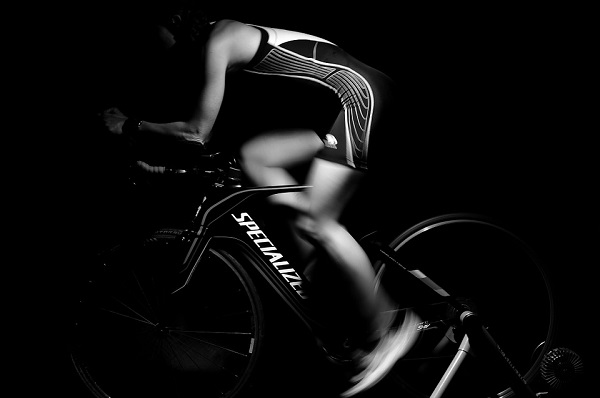
Indoors or not, hydration practices matter and can greatly impact your performance. Read on to discover the ways to mitigate dehydration when on the trainer.
Across much of the world, winter has arrived along with colder temperatures that force many athletes indoors. Gone are the days of open-water swims and day-long bike rides, replaced by shorter, more intense efforts on the indoor trainer or treadmill.
One thing that doesn’t go away? The sweating.
As anyone who has completed even a single hard indoor workout knows, trainer or treadmill sessions can be brutal. And unless you are masochistic enough to set up your gear in a garage that exposes you to the winter temperatures, these workouts probably take place in a warm, humid environment. While this is great for escaping the winter blues, it is not much help when it comes to keeping cool.
Do you actually sweat more indoors?
Anecdotally, many runners and triathletes believe they sweat more indoors. Ultimately, though, the answer is “it depends.” Just as the outdoor environment can be influenced by myriad factors, including temperature, humidity levels, precipitation, wind speed and shade cover, various aspects of your indoor setup can affect how much you sweat.
Many experts believe, however, that at a minimum your sweat rate inside is at least equal to what it would be outside.
“Depending on your objective for the ride (aerobic, strength, drills, intervals) and the duration, you may or may not require a bit more fluid when on the indoor bike trainer,” writes Bob Seebohar, RD, an endurance coach and former sports dietitian for the U.S. Olympic triathlon team. “[Various conditions] can lead to a greater sweat rate and loss of fluid, which is often the case when riding a turbo trainer indoors.”
What is causing this high sweat rate?
Again, each situation is different, but there are a few common differences between indoor and outdoor workouts.
The first is intensity. When riding outdoors, perceived effort is often lower due to the ability to coast in certain spots, as well as the distraction of the outdoor scenery. On a trainer, an athlete must pedal consistently throughout the workout, eliminating the ability to coast and upping the overall intensity. A study in the Journal of Applied Physiology found that workout intensity is highly correlated with sweat rate, so it naturally makes sense that the intense indoor workouts will produce a higher sweat rate.
The second is air flow. When riding outdoors, no matter the temperature, athletes have the benefit of air flow to help keep them cool. Air flow helps sweat evaporate, which is an essential step in the cooling process. Inside, this air flow is greatly reduced or completely nonexistent, so the sweat often just hangs on the skin (or pools around the bottom of the front tire), reducing the cooling effect. This prompts the body to sweat even more.
How does this impact your workout?
Dehydration negatively impacts workout performance. The human body relies on a balance of water, calories and electrolytes to fuel exercise, and despite some of today’s Internet rumors, there is no situation when running low in any of these categories boosts output. Thus, when working out, the smart athlete will replace all three in the ideal ratios.
Even a two percent reduction in your body weight from fluid loss can begin to impair performance, and three percent is considered to do so “significantly.” Beyond that, and many experts believe an athlete is putting him or herself in a potentially dangerous situation.
Of course, sweat contains more than just water, and athletes will need to replace adequate levels of electrolytes as well, including sodium, potassium, magnesium and calcium. To see this in action, consider the results of a small double-blind, placebo-controlled 2015 study, which found measurable performance improvements in athletes who replaced adequate amounts of sodium compared to athletes who did not.
What can you do about it?
As noted above, the smart athlete will work to replace both water and electrolytes during a workout in the optimal ratios.
Sports drinks may help, but for workouts longer than 60 minutes, it may be beneficial to supplement with a solid electrolyte product such as SaltStick. Here’s why: Sweat typically has about 1,000 mg sodium/liter, but due to concerns about taste, a typical sports drink has only 440 mg sodium/liter. Otherwise, the product would taste like seawater.
Simple math illustrates that if, during the course of training, you ingest nothing but sports drinks (or worse, water), your electrolyte stores will become too low compared to your water stores, a medical condition known as hyponatremia.
So what does this mean practically? We suggest consuming one to two SaltStick Caps per hour while drinking to thirst. SaltStick is uniquely formulated to closely resemble the electrolyte profile lost during activity: Each capsule contains: 215 mg sodium, 63 mg potassium, 22 mg calcium and 11 mg magnesium. Check out our usage guides here for more details.
Additionally, many experts believe that drinking to thirst is one of the best ways to prevent overhydration. Combine these two together, and you have a set of best practices that still provide enough flexibility to allow for your unique needs.
Happy training!